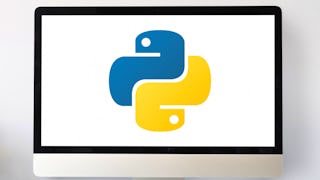Whether you’re a scientist, engineer, student, or industry professional working with data or quantitative tasks, this course is your gateway to solving real-world problems with Python. Designed for beginners, no prior programming experience is required. We start with the basics and build up to powerful tools and techniques used every day in research and industry. You’ll learn how to fit data to custom models, automate repetitive tasks, create clear and professional visualizations, work efficiently with arrays, solve optimization problems, integrate and differentiate mathematical functions, and more using essential libraries like NumPy and SciPy.



Introduction to Python for Scientific Computing


Instructors: Carolyn Kohlmeier
Access provided by University of Toronto
2,631 already enrolled
(13 reviews)
Recommended experience
What you'll learn
Apply Python programming concepts to develop structured, efficient code for scientific analysis
Perform numerical and symbolic computations using Python libraries to solve real-world scientific problems
Visualize data effectively using Python’s plotting libraries
Select and apply appropriate Python tools and techniques to model, analyze, and solve scientific problems
Skills you'll gain
Details to know

Add to your LinkedIn profile
4 assignments
July 2025
See how employees at top companies are mastering in-demand skills

There are 4 modules in this course
This module lays the groundwork for using Python in scientific computing. You’ll get familiar with Python's syntax and basic concepts, including variables, data types, type conversions, and how to use Python as a powerful calculator. We’ll also introduce you to objects, methods, attributes, and basic plotting so you can begin working with data early in your journey.
What's included
14 videos1 reading1 assignment1 programming assignment1 discussion prompt1 ungraded lab
Building on the basics, this module introduces programming logic and modular thinking. You’ll explore Python’s control flow tools—like loops and conditionals—and learn how to write reusable, well-structured functions. We’ll also discuss debugging strategies to help you troubleshoot your code more effectively.
What's included
11 videos1 assignment1 programming assignment1 ungraded lab
This module focuses on working with structured numerical data. You’ll learn how to manipulate arrays using NumPy, perform matrix operations, and fit mathematical models to data. You’ll also explore Python’s visualization capabilities to create effective 2D and 3D plots for scientific communication.
What's included
8 videos1 assignment1 programming assignment1 ungraded lab
In this final module, you’ll explore powerful numerical and symbolic tools in Python. Topics include solving equations, optimization, curve fitting, and numerical integration. These skills are essential for tackling complex scientific problems and performing high-level data analysis.
What's included
9 videos1 assignment1 programming assignment1 ungraded lab
Instructors

Offered by
Why people choose Coursera for their career




Learner reviews
13 reviews
- 5 stars
92.85%
- 4 stars
7.14%
- 3 stars
0%
- 2 stars
0%
- 1 star
0%
Showing 3 of 13
Reviewed on Nov 8, 2025
Very good course for optimization basics understanding. I would request you to please make a course on computational biology and chemistry. It would be really amazing!!!
Reviewed on Sep 23, 2025
Excellent overview, introducing a wide range of modules and functions for scientific computing. Very clear tuition. Jupyter Notebooks are an excellent resource.
Reviewed on Aug 24, 2025
Fascinating topic. Presented well. Easy to follow.
Explore more from Data Science

Ball State University

Imperial College London

Google


